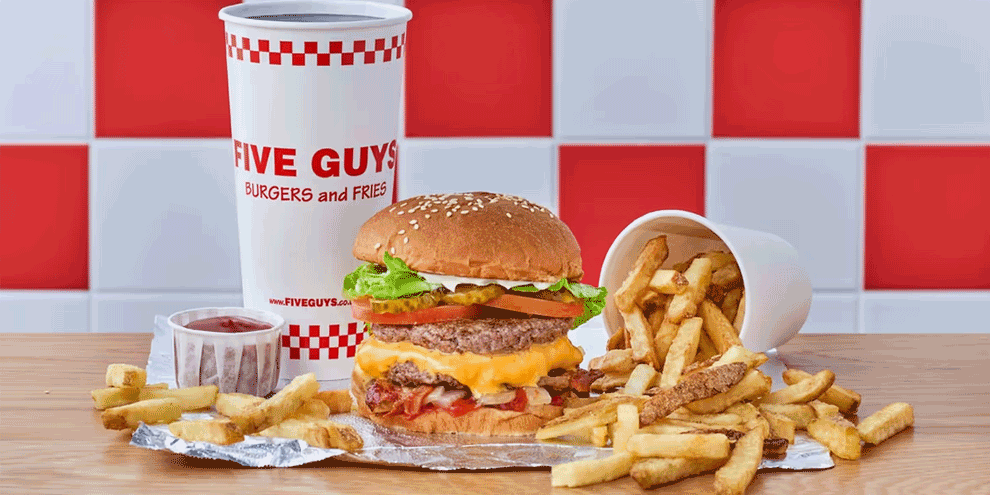No dollar menu here: freshness, quality keep small burger chain going
 Wendy’s fast-food restaurants made a splash in 2008 with their fresh-never-frozen ground beef patties and their customer greeting “What can we make fresh for you?”, but one lesser-known hamburger joint has been thriving on those same principles since it opened its first restaurant in Arlington, Va., in 1986 - long before the emphasis on fresh, quality fast-food became popular among the largest chains.Five Guys Burgers and Fries, a Washington, D.C.-based fast-food chain has helped spawn the national trend toward fresh ingredients cooked to order and served in a fast-food setting. Five Guys has been keen to the consumer craving for high-quality food over cheap-and-easy food, and it has reaped the rewards as it expanded its reach to 300+ locations in 25 states. The chain sticks to a small, trans-fat-free menu and focuses on preparing its few items to perfection, according to Sylvia Rector’s January 22, 2009, article “Five Guys gets fresh with burgers,” in the Detroit Free Press .
Wendy’s fast-food restaurants made a splash in 2008 with their fresh-never-frozen ground beef patties and their customer greeting “What can we make fresh for you?”, but one lesser-known hamburger joint has been thriving on those same principles since it opened its first restaurant in Arlington, Va., in 1986 - long before the emphasis on fresh, quality fast-food became popular among the largest chains.Five Guys Burgers and Fries, a Washington, D.C.-based fast-food chain has helped spawn the national trend toward fresh ingredients cooked to order and served in a fast-food setting. Five Guys has been keen to the consumer craving for high-quality food over cheap-and-easy food, and it has reaped the rewards as it expanded its reach to 300+ locations in 25 states. The chain sticks to a small, trans-fat-free menu and focuses on preparing its few items to perfection, according to Sylvia Rector’s January 22, 2009, article “Five Guys gets fresh with burgers,” in the Detroit Free Press .
Five Guys doesn’t have a freezer because nothing it serves is frozen. Its ground beef arrives fresh, and its skin-on french fries are cut by hand in the kitchen every day. To emphasize the point, the company stores its Idaho spuds in 50-pound bags in the dining room, where they wait their turn to be scrubbed and then run individually through a lever-operated french-fry cutter in back.
The company focuses on two products: hamburgers, served with your choice of 17 toppings, and its immensely-popular french fries, cooked in 100-percent peanut oil. Regular hamburgers come with two 3.4-ounce patties ($4.39); so-called little burgers have one patty ($3.29). Diners are invited to load their burgers to ridiculous heights; there’s no extra charge for toppings other than cheese and bacon. The only other menu items are big kosher hot dogs and grilled cheese or veggie sandwiches.
GLBT consumers on top of the trends
Nearly half of gay and lesbian adults report they like to keep up with the latest styles and trends, compared to only 38 percent of heterosexual adults, according to a study from Rochester, N.Y., research company Harris Interactive.Taking a look only at gay men in the sample, 53 percent report they like to keep up with the latest styles and trends, compared to fewer than one-third of heterosexual men. In January 2007, when the same question was posed in a similar survey, 39 percent of gay men reported that they keep up with the latest styles and trends, compared to 32 percent of heterosexual males.Gay and lesbian adults are also more likely than their heterosexual counterparts to upgrade to the latest model or version of a product. Forty-five percent of gay and lesbian adults say they tend to upgrade, compared to one-third of heterosexual adults. Just looking at gay men, 49 percent report they tend to upgrade, compared to 35 percent of heterosexual men.
The survey confirms a demographic distinction between gay/lesbian consumers and heterosexual consumers. “The LGBT community has long been known not just for trend spotting but also trendsetting,” said Wes Combs, president of Witeck-Combs Communications, a Washington, D.C., GLBT public relations company. “They are very savvy consumers and often motivated to spend a little extra on new products and upgrades.”
Protestants most willing to branch out and test the holy waters
Seven out of 10 regular churchgoers would be at least somewhat open to switching denominations, and another 44 percent report having one preferred denomination but would also consider others, according to a study from Ellison Research, Phoenix. Eleven percent have a small number of denominations they would consider, with no particular favorite among them; 6 percent don’t have any particular denomination they prefer, but they do have certain ones they would not consider; and 9 percent say denomination does not factor into their decision of what church to attend.
Denominational loyalty differs strongly between Protestants and Catholics. Six out of 10 active Catholics would only consider attending a Roman Catholic church, and another 29 percent prefer this, although they do not rule out other denominations. Eleven percent of Catholics do not show a specific preference for attending a Catholic parish.
In comparison, just 16 percent of Protestant churchgoers will only consider attending their current denomination. Fifty-one percent do express preference for one denomination, but would also consider others. Thirty-three percent do not have any preference for one specific denomination.
Oddly enough, the devotion Catholics feel for their particular denomination does not translate into every area of their lives, namely brand loyalty. When asked about their loyalty to specific brands within 32 individual categories of products, services and stores, Roman Catholics are far more likely to be loyal to their denomination than they are to be loyal to specific brands within any consumer category.
The story is much different for Protestants; several consumer categories indicate brand loyalty levels consistent with loyalty to a particular denomination. As noted earlier, 16 percent of Protestant churchgoers are exclusively loyal to one denomination, and a total of 67 percent have a preferred denomination (even if they will consider others). Types of consumer products or services that show similar levels of brand loyalty among Protestant churchgoers include toothpaste (22 percent exclusive to one brand, with 64 percent expressing a brand preference); bathroom tissue (19 percent exclusive to one brand, with 59 percent expressing a brand preference); pain reliever (16 percent exclusive to one brand, with 57 percent expressing a brand preference); soft drinks (14 percent exclusive to one brand, with 70 percent expressing a brand preference); automobiles (11 percent exclusive to one brand, with 64 percent expressing a brand preference); and grocery stores (9 percent exclusive to one brand, with 66 percent expressing a brand preference).
